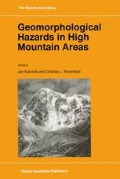Abstract
Among other geomorphologic hazards, landslides are a common feature in high mountain areas like the Himalayan Range (cf. Shroder 1989). On the southern flanks of the Himalayas, specially the Low and Middle Himalaya, landslides, representing the dominant hillslope process (Whitehouse 1990), are of special concern as they cause permanent loss of agricultural land (Ives & Messerli 1981), block important roads and even destroy housing (cf. Schelling 1988). The dominance of landslides in this region can be attributed to lithology, the tectonic stress applied to the rocks and steep relief In addition the climatic conditions promote deep weathering and provide landslide triggering rainfall events, generally mainly during the monsoon (cf. Kienholz et al. 1982, Bartaiya & Valdiya 1989).
Access this chapter
Tax calculation will be finalised at checkout
Purchases are for personal use only
Preview
Unable to display preview. Download preview PDF.
References
Autodesk Inc. (1995) AutoCAD Release 13 — „User’s Guide“, Autodesk-Trademark, N.N.
Baade, J., Mäusbacher, R., Wagner, G.A. (in press): Der Einfluß von klimatischen Veränderungen und Natur-ereignissen (Katastrophen) auf die Siedlungsprozesse in Mustang, Tibetischer Himalaya, Jenaer Geographische Manuskripte.
Bartarya, S.K., Validiya, K.S. (1989) Landslides and erosion in the catchment of the Gaula River, Kumaun Lesser Himalaya, India, Mountain Research and Development 9(4), 405–419.
Bilham, R., Bodin, P., Jackson, M. (1995) Entertaining a great earthquake in Western Nepal: Historic inactivitiy and geodetic test for the development of strain, Journal of Nepal Geological Society 11, 73–88.
Climatological records of Nepal 1977ff., published by Department of Irrigation, Hydrology and Meteorology, Ministry of Food, Agriculture and Irrigation, Kathmandu.
Crozier, M.J. (1986) Landslides: causes, consequences and environment, Croom Helm, London.
Eastman, J.R. (1995) Idrisi for Windows, User’s Guide, Worcester.
Flohn, H. (1970) Beiträge zur Meteorologie des Himalaya., Khumbu Himal 7(2), 25–45.
Fort, M. (1987) Geomorphic and hazards mapping in the dry, continental Himalaya: 1:50,000 maps of Mustang District, Nepal, Mountain Research and Development 7(3), 222–238.
Fort, M., Freytet, P., Colchen, M. (1982) Structural and sedimentologicai evolution of the Thakkhola Mustang Graben (Nepal Himalayas), Zeitschrift für Geomorphologie, N.F., Suppl.Bd. 42, 75–98.
Fort, M., White, P.G., Shrestha, B.L. (1984) 1:50.000 geomorphic hazards mapping in Nepal., FLAGEOLLET, J.-C. (Ed.): Mouvement de terrains. Communications du colloque, Caen, 22–24 mars 1984 185–194.
Fuchs, H., Leberl, F. (1980) „CRISP“, A software package for close range photogrammetry for the KERN DSR1, Aarau.
Haffner, W., Pohle, P. (1993) Settlement processes and the formation of state in the high Himalayas characterized by Tibetan culture and tradition., Ancient Nepal 134, 42–56.
Hagen, T. (1959) Geologie des Thakkhola (Nepal)., Eclogae Geologicae Helvetia 52, 708–720.
Hagen, T. (1968) Report on the geological survey of Nepal. Vol. 2: Geology of the Thakkhola including adjacent areas, Denkschrift der Schweizerischen Naturforschenden Gesellschaft 86/2..
Hüttel, H.-G. (1994) Archäologische Siedlungsforschung im Hohen Himalaja. Die Ausgrabungen der KAVA im Muktinath-Tal/Nepal 1991–1992, Beiträge zur allgemeinen und vergleichenden Archäologie 14, 47–147.
Ives, J.D., Messerli, B. (1981) Mountain hazards mapping in Nepal — Introduction to an applied mountain research project, Mountain Research and Development 1(3–4), 223–230.
Iwata, S., Yamanaka, H., Yoshida, M. (1982) Glacial landforms and river terraces in the Thakkhola Region, Central Nepal, Journal of Nepal Geological Society 2(Special Issue), 81–94.
Kienholz, H., Hafner, H., Schneider, G. (1982) Zur Beurteilung von Naturgefahren und der Hanglabilität — Ein Beispiel aus dem nepalischen Hügelland, HAFFNER, W. (Ed.): Tropische Gebirge: Ökologie und Agrarwirtschaft, Gießener Beiträge zur Entwicklungsforschung, Reihe I, 8, 35–56.
Le Fort, P., France-Lanord, C. (1995) Granites from Mustang and surrounding regions (Central Nepal), Journal of Nepal Geological Society 11, 53–58.
Messerschmidt, D.A. (1989) The Hindu Pilgrimage to Muktinath, Nepal. Part 1. Natural and supranatural attributes of the sacred field, Mountain Research and Development 9(2), 89–104.
Pohle, P. (1993) Geographical research on the cultural landscape of Southern Mustang. The land use map of Kagbeni as a basis, Ancient Nepal 134, 57–81.
Pohle, P. (1994) Wüstungen als Zeugen von Siedlungsprozessen im Tibetischen Himalaya (Süd-Mustang)., Fehn, K. (Ed.): Siedlungsforschung. Archäologie — Geschichte — Geographie. 12, Verlag Siedlungsforschung, Bonn, 327–340.
Röthlisberger, F. (1986) 10 000 Jahre Gletschergeschichte der Erde, Verlag Sauerländer, Aarau.
Schelling, D. (1988) Flooding and road destruction in Eastern Nepal., Mountain Research and Development 8, 78–79.
Shrestha, S.H. (1988) Nepal in maps, White Orchid Books, Kathmandu.
Shroder, J.F.Jr. (1989) Hazards of the Himalaya, American Scientist 77, 564–574.
Simons, A., Schön, W., Shresta, S.S. (1994) Preliminary report on the 1992 campaign of the team of the Institute of Prehistory, University of Cologne, Ancient Nepal 136, 51–75.
von Rad, U., Dürr, S.B., Ogg, J.G., Wiedmann, J. (1994) The Triassic of the Thakkola (Nepal). I: stratigraphy and paleoenvironment of the north-east Gondwana rifted margin, Geologische Rundschau 83, 76–106.
Whitehouse, I.E. (1990) Geomorphology of the Himalaya: A climato-tectonic framework, New Zealand Geographer 46(2), 75–85.
Author information
Authors and Affiliations
Editor information
Editors and Affiliations
Rights and permissions
Copyright information
© 1998 Springer Science+Business Media Dordrecht
About this chapter
Cite this chapter
Baade, J., Mäusbacher, R., Wagner, G.A., Heine, E., Kostka, R. (1998). Landslides and Deserted Places in the Semi-Arid Environment of the Inner Himalaya. In: Kalvoda, J., Rosenfeld, C.L. (eds) Geomorphological Hazards in High Mountain Areas. The GeoJournal Library, vol 46. Springer, Dordrecht. https://doi.org/10.1007/978-94-011-5228-0_3
Download citation
DOI: https://doi.org/10.1007/978-94-011-5228-0_3
Publisher Name: Springer, Dordrecht
Print ISBN: 978-94-010-6200-8
Online ISBN: 978-94-011-5228-0
eBook Packages: Springer Book Archive

